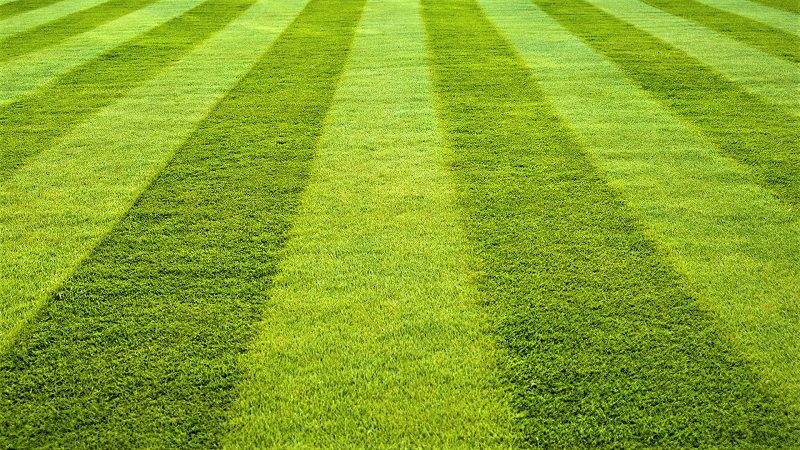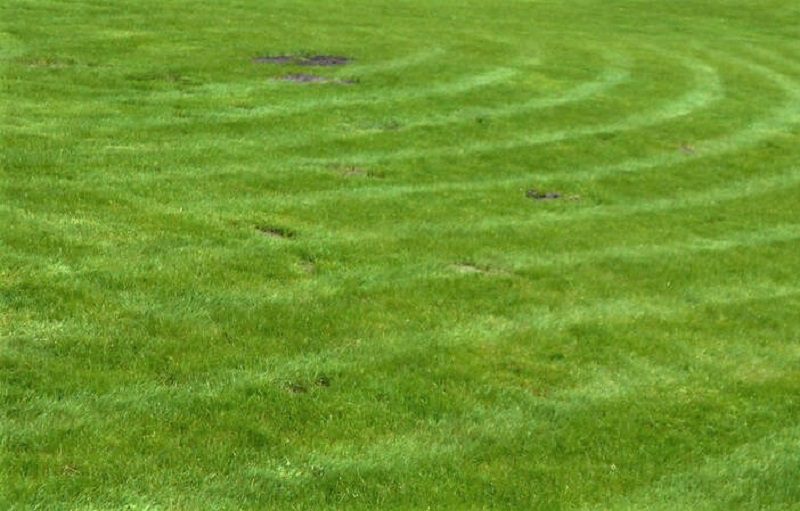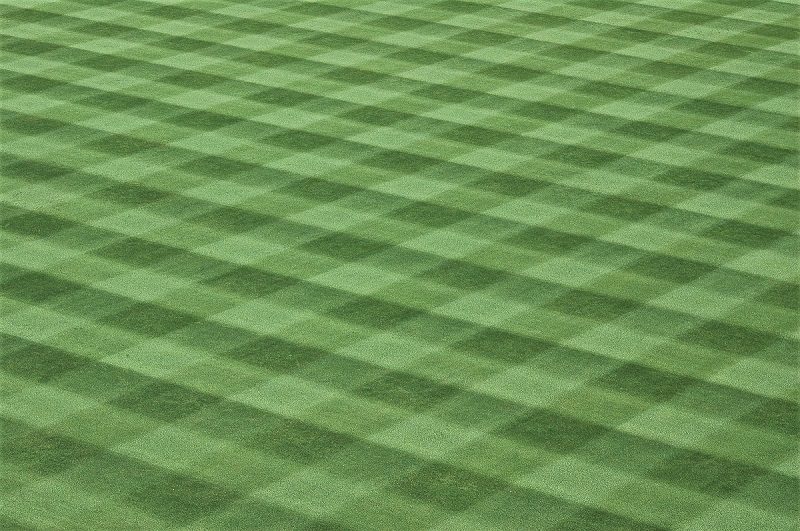Last Updated on May 2, 2024 by teamobn

If you tend to a garden, chances are you’ve heard of garden art before. You’ve probably seen pictures of elaborately shaped hedges in gardening magazines, too. But what about lawn mower art?
We don’t just mean those perfectly uniform lines at Wimbledon and Wembley. We mean art that’s cut into the grass, much like crop circles.
Increasingly, you’ll find lawn mowing pattern art on the lawns of gardening enthusiasts and in the statelier grounds of country manors.
The Basics of Lawn Mowing Patterns
Contents
While some of the most intricate lawn mower art can be intimidating, learning the basics can be fun. If you’ve been mowing lawns for a while now, then you might want to try a few basic patterns.
While there are countless different patterns to try, these four can get you started on a new and interesting hobby.
1. Stripes
For this lawn mowing pattern, mow a straight, even first stripe. Keep in mind a “line of sight” to use as a guide for the rest of the stripes. Mow in slow Y-turns rather than making sharp turns. Sharp turns with a lawn mower can damage grass.
The direction that the grass is bent determines the light- or dark-colored stripe. When the blades of grass are bent away from you, the grass appears lighter. That is because the light is reflected off the wide, lengthy part of the blade.
When the blades of grass are bent towards you, the grass appears darker as you are looking more of the tips of the blades. These present a smaller reflective surface. So, cutting a lawn in an opposing pattern – up and down, right and left – allows the most contrast.

2. Diamonds
To make this lawn mowing pattern, start by mowing the first diagonal stripe down the center of the lawn. Then mow another stripe right next to it. Move around the edge of the lawn and mow a second stripe in the same direction. This creates one light stripe with two dark stripes next to it.
Continue this pattern until both sides of the lawn are striped. Make the crossing stripes by making a diagonal first stripe in the opposite direction. Then make a return pass right next to it, just like the first time.
Continue the same pattern, one stripe then two stripes back. Do this until the lawn is completely cut.

3. Circles
Circles are an excellent lawn mowing pattern for highlighting flowerbeds, trees, and other features on your lawn. When mowing circles, instead of starting to mow from the edge of the yard, start from the middle and mow outwards.
If you don’t have a circular flowerbed or feature in the middle of the lawn, use a substitute with any circular item. Use this as a guide to mow your first circle.
Mow the second circle in the opposite direction. This will permit you to achieve a pronounced circular effect. Use the first circle as a guide.
One wheel of your mower should align with the first circle’s outer ring. Continue to mow in circles in alternating opposite directions until you get to the edge of the lawn.

4. Checkerboard
Do you want to try an elaborate lawn mowing pattern? Why not try a checkerboard lawn pattern? You achieve the look in almost the same way as when you choose a diamond pattern. Start by mowing parallel to a straight sidewalk or driveway. To keep mowing straight, look 10 feet ahead while you mow.
When you come to the end of a row, lift the mower deck as you turn. That done, mow in the opposite direction next to your previous pass.
To create a checkerboard, mow the lawn a second time at 90 degrees to your first mowing. Finish by mowing a strip around the edges of the lawn.

Seasonal Lawn Care Tips
Proper lawn care varies throughout the year as the seasons change. Understanding how to adapt your maintenance routine can enhance the health of your lawn and the clarity of your mowing patterns.
Here, we’ll explore essential tips for keeping your lawn in top condition, ensuring that your lawn mowing patterns remain crisp and visible no matter the season.
Spring Preparation
- Reviving Your Lawn for Spring: Spring is a critical time for setting the stage for healthy grass and clear patterns. Begin by clearing any debris and thatch that may have accumulated over the winter. This cleanup allows the grass to breathe and grow more evenly, which is crucial for maintaining distinct lawn mowing patterns. It’s also the perfect time to sharpen your mower blades to ensure clean cuts that enhance the visual appeal of your lawn patterns.
- Fertilization and Aeration: Apply a balanced fertilizer to promote vigorous growth. Consider aerating your lawn to improve nutrient absorption and water penetration. A well-aerated lawn provides a solid foundation for intricate lawn mowing patterns by promoting uniform grass health.
Summer Maintenance
- Regular Mowing: Keep your lawn mowed regularly to maintain the integrity of your lawn mowing patterns. Adjust the mowing height according to the heat; raise the blade during hotter months to reduce grass stress and prevent the lawn from looking worn. Taller grass can also help shade the soil and reduce weed growth.
- Watering Wisely: Water your lawn deeply but infrequently to encourage deep root growth, which supports healthier and more drought-resistant grass. The best time to water is early in the morning, which helps prevent evaporation and fungal growth. Consistent growth is key to maintaining sharp, defined mowing patterns.
Autumn Care
- Prepping for Dormancy: As temperatures drop, prepare your lawn for dormancy. This is a good time to apply a fertilizer rich in potassium to enhance resistance to cold and disease. Continue mowing as necessary, gradually lowering the cutting height back to normal to prevent the grass from matting under snow.
- Leaf Management: Rake leaves regularly to prevent them from smothering the grass and obscuring your lawn mowing patterns. Consider mulching leaves to provide nutrients back to the lawn as they decompose.
Winter Strategies
- Protecting Your Lawn: During winter, minimize foot traffic on your lawn to protect the dormant grass. Clear paths of ice and snow promptly to prevent damage and ensure that your lawn mowing patterns are ready to reappear beautifully in the spring.
By following these seasonal lawn care tips, you can ensure that your lawn remains healthy and your mowing patterns sharp year-round. Adjusting your care routine to suit the changing seasons is key to achieving a standout lawn that captures attention and compliments.
Lawn Mowing Patterns and Lawn Health
Maintaining a healthy lawn involves more than regular watering and fertilizing; it also includes the strategic use of lawn mowing patterns. Not only do these patterns enhance the aesthetic appeal of your yard, but they also play a significant role in promoting lawn health.
Here’s how you can use mowing patterns to benefit your grass while keeping your lawn looking its best.
Impact of Mowing Patterns on Grass Health
- Promoting Growth Direction: Consistently mowing your lawn in the same pattern can influence the direction in which your grass blades lean. For optimal health and visual effect, it’s beneficial to alternate patterns. This practice prevents the grass from lying too flat, which can hinder growth and diminish the pattern’s visibility.
- Reducing Wear and Tear: Alternating your lawn mowing patterns helps distribute wear more evenly across the surface. This is particularly important for lawns with heavy foot traffic or under harsh sunlight. By changing the mowing direction, you ensure no single area is overly stressed, keeping the grass healthier and the patterns more distinct.
Best Practices for Mowing Patterns
- Sharp Blades for Clean Cuts: Always use sharp mower blades. Dull blades can tear the grass, leading to frayed and discolored edges that compromise both lawn health and the appearance of your mowing patterns. Clean cuts promote quicker healing and reduce the risk of disease.
- Adjusting Mowing Height: The height at which you cut your grass can significantly affect its health and the quality of the mowing patterns. Avoid cutting grass too short, as this can stress the grass and make it more susceptible to diseases. Keeping the blades a bit higher protects the roots and enhances the grass’s ability to photosynthesize, which is crucial for maintaining vibrant patterns.
- Consistency in Mowing Frequency: Regular mowing helps train the grass to grow more densely, improving both the lawn’s overall health and the precision of the mowing patterns. Dense growth reduces weed infiltration and ensures that patterns are clean and visible.
Mowing Techniques for Enhanced Patterns
- Using the Right Equipment: Consider using a lawn mower equipped with a striping kit. These kits help bend the grass more effectively, creating more pronounced and longer-lasting patterns. The stripes or designs you create are the result of light reflecting off the grass blades, so the more uniform your mowing technique, the more striking the patterns.
- Directional Mowing for Optimal Health: To maximize the health benefits and visual impact of your lawn mowing patterns, alternate between horizontal, vertical, and diagonal passes. This variation helps prevent soil compaction and grass wear, both of which can detract from your lawn’s appearance and health.
By understanding the relationship between lawn mowing patterns and lawn health, you can create a stunning visual landscape that is also conducive to strong, healthy grass growth. Carefully planned and executed patterns not only boost curb appeal but also contribute significantly to the sustainability and vitality of your lawn.
Make Lawncare Less of a Chore!
Creating different lawn mowing patterns are a fun and unique way to make lawn maintenance less of a chore. They set your yard apart. A good pattern can boost curb appeal and property value. Certain patterns draw the eye inward, too, which means you can highlight your house even more. Be creative. Try combinations of patterns where these might apply.
But no matter what pattern you choose, always keep basic lawn mowing pattern tips in mind. Keep your mower blades sharp to ensure an even cut. Mow when grass is dry as it’s best for the grass and mower performance.








